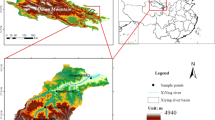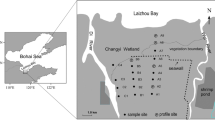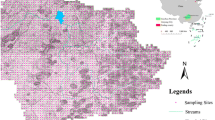Abstract
We selected four kinds of land use types from Caohai wetlands of Guizhou plateau (a total number of 32 soil profiles) to study the distribution characteristics of organic carbon content in soil. With different ways of land use, the organic carbon content of soil profiles and organic carbon density show the tendency of decreasing firstly and then increasing from top to bottom. With the increase of depth, the vertical difference becomes smaller first and then starts increasing. Land reclamation reduces the soil organic carbon content and density, changing its distribution structure in topsoil. The average content of organic carbon in Caohai wetlands are as follows: lake bed silt > marsh wetland > farmland > woodland, the average organic carbon content of lake bed silt, marsh wetland, farmland and woodland are 16.40, 2.94, 1.81 and 1.08 %, respectively. Land reclamation reduces the organic carbon content of soil, therefore the conversion of cultivated lands to wetlands and the increase of forest coverage will help to fix the organic carbon in soil and increase its reserves.




Similar content being viewed by others
References
Amber DN, Ken WB (2011) The contribution of carbon-based payments to wetland conservation compensation on agricultural landscapes. Agric Syst 104(1):75–81
Aselmann I, Crutzen PJ (1989) Global distribution of natural freshwater wetlands and rice paddies, their net primary productivity, seasonality and possible methane emissions. J Atmos Chem 8(4):307–358
Barretta JE, Virginia RA, Parsons AN, Wall DH (2006) Soil carbon turnover in the McMurdo Dry Valleys, Antarctica. Soil Biol Biochem 38(10):3065–3082
Birol K, Miklas S, Atif M, Åsa H (2010) Carbon storage and fluxes within freshwater wetlands: a critical review. Wetlands 30(1):111–124
Chhabra A, Palria S, Dadhwal VK (2003) Soil organic carbon pool in Indian forests. For Ecol Manag 173(1):187–199
Euliss NH Jr, Gleason RA, Olness A, McDougal RL, Murkin HR, Robarts RD, Bourbonniere RA, Warner BG (2006) North American prairie wetlands are important nonforested land-based carbon storage sites. Sci Total Environ 361(1):179–188
Gorham E (1991) Northern peatlands: role in the carbon cycle and probable responses to climatic warming. Ecol App 1(2):182–195
Hu Y, Li YL, Wang L, Tang YS, Chen JH, Fu XH, Le YQ, Wu JH (2012) Variability of soil organic carbon reservation capability between coastal salt marsh and riverside freshwater wetland in Chongming Dongtan and its microbial mechanism. J Environ Sci (China) 24(6):1053–1063
Julian JC, Dawson Pete S (2007) Carbon losses from soil and its consequences for land-use management. Sci Total Environ 382(2):165–190
Lemly AD, Kingsford RT, Thompson JR (2000) Irrigated agriculture and wildlife conservation: conflict on a global scale. Environ Manag 25(5):485–512
Li Z, Zhao Q (2001) Organic carbon content and distribution in soils under different land use in tropical and subtropical China. Plant Soil 231(2):175–185
Lü YH, Sun RH, Fu BJ, Wang YF (2012) Carbon retention by check dams: regional scale estimation. Ecol Eng 44(1):139–146
Maltby E, Immirzi P (1993) Carbon dynamics in peatlands and other wetland soils: regional and global perspectives. Chemosphere 27(6):999–1023
Matthews E, Fung I (1987) Methane emissions from natural wetland lands: global distribution, area and environmental characteristics of sources. Glob Biogeochem Cycle 1:61–86
Naklang K, Whitebread A, Lefroy R, Blair G, Wonprasaid S, Konboon Y, Suriya-arunroj D (1999) The management of rice straw, fertilisers and leaf litters in rice cropping systems in Northeast Thailand. Plant Soil 209:21–28
Schleisinger WH (1990) Evidence from chronosequence studies for a low carbon storage potential of soils. Nature 348(15):232–234
Sombroek WG, Nachtergael FO, Hebel A (1993) Amounts, dynamics and sequestering of carbon in tropical and subtropical soils. Ambio 22(7):417–426
Song GH, Li LQ, Pan GX, Zhang Q (2005) Topsoil organic carbon storage of China and its loss by cultivation. Biogeochemistry 74(1):47–62
Sulman BN, Desai AR, Cook BD, Saliendra N, Mackay DS (2009) Contrasting carbon dioxide fluxes between a drying shrub wetland in Northern Wisconsin, USA, and nearby forests. Biogeosciences 6(6):1115–1126
van Roon MR (2012) Wetlands in The Netherlands and New Zealand: optimising biodiversity and carbon sequestration during urbanization. J Environ Manag 101(30):143–150
Wang CK (2006) Biomass allometric equations for ten co-occurring tree species in Chinese temperate forests. For Ecol Manag 222(1):9–16
Wang SQ, Zhou CH, Li KR, Zhu SL, Hang FH (2000) Analysis on spatial distribution characteristics of soil organic carbon reservoir in China. Acta Geograph Sin 55(5):523–543
Wang H, Wang RQ, Yu Y, Myron JM, Zhang LJ (2011) Soil organic carbon of degraded wetlands treated with freshwater in the Yellow River Delta, China. J Environ Manag 92(10):2628–2633
William JM, Julio T, Amanda N, Bert K, Blanca B, Carlos EH (2008) Tropical wetlands for climate change research, water quality management and conservation education on a university campus in Costa Rica. Ecol Eng 34(4):276–288
Yang YH, Fang JY, Tang YH, Ji CJ, Zheng CY, He JS, Zhu B (2008) Storage, patterns and controls of soil organic carbon in the Tibetan grasslands. Glob Change Biol 14(7):1592–1599
Yu GR, Li HT, Wang SQ (2003) Global change, carbon cycle and storage in terrestrial ecosystem. Meteorological Press, Beijing, p 43
Zhang WJ, Xiao HA, Tong CL, Su YR, Xiang WS, Huang DY, Keith Syers J, Wu JS (2008) Estimating organic carbon storage in temperate wetland profiles in Northeast China. Geoderma 146(1):311–316
Zhang YH, Ding WX, Luo JF, Andrea D (2010) Changes in soil organic carbon dynamics in an Eastern Chinese coastal wetland following invasion by a C4 plant Spartina alterniflora. Soil Biol Biochem 42(10):1712–1720
Acknowledgments
This research was supported by Project of Guizhou Special Funds for High-level Personnel (Grant Number TZJF-2011-44), Program for New Century Excellent Talents in University (NCET-12-0659), and Project of Guizhou Governor Capital Fund (Guizhou province designed cooperative [2012]71).
Author information
Authors and Affiliations
Corresponding author
Additional information
The online version is available at http://www.springerlink.com
Corresponding editor: Chai Ruihai
Rights and permissions
About this article
Cite this article
Wu, Y., Wang, F. & Zhu, S. Vertical distribution characteristics of soil organic carbon content in Caohai wetland ecosystem of Guizhou plateau, China. J. For. Res. 27, 551–556 (2016). https://doi.org/10.1007/s11676-015-0086-0
Received:
Accepted:
Published:
Issue Date:
DOI: https://doi.org/10.1007/s11676-015-0086-0




